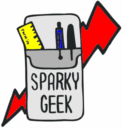I’m giving my grow light more horsepower this year. I did a little research on fluorescent bulbs and learned that the bulbs will withstand higher current flow, which results in higher light output. This higher output comes at the cost of higher energy use and lower bulb life. A common way of achieving this is ‘overdriving’ the bulbs by rewiring the fixture. There is lots of information on the interwebs about this, and it is pretty confusing because most of the information seems to be written by people who have accomplished something without understanding what is really going on. Here is my explanation:
Fluorescent bulbs have the property that they conduct better as they heat up, so it is critical that the current be controlled through the bulb. This is the job of the ballast. Traditionally this was done by taking advantage of the fact that standard electricity changes direction 120 times per second and the properties of an inductor to limit fast current changes. These types of ballasts are known as magnetic, and are the cheapest ones you can buy today. Modern times brought electronic ballast that are more efficient because they increase the switching frequency to send more pulses to the bulbs per second.
Using an electronic ballast, it is possible to drive a single bulb with the output intended for 2 bulbs (or 3 or 4). The cheapest (initially) way to accomplish this is to buy 2 cheap shop light fixtures from Home Depot ($10 each), remove the ballast from one of the fixtures and install it in the other fixture. Rewire both ballast so that each ballast (designed to drive 2 bulbs) drives only one bulb. So for $20, you have one fixture with 2 ballast, and one fixture that is now a skeleton. For the fixture that is cannibalized, I’m going to use a single new electronic ballast designed for 4 bulbs, and wire it to power the 2 bulbs.
Notes:
Home Depot Shop Light fixture = $10
T12F40 plant bulb = $10 each
—
Rapid start ballasts (such as the SL15) constantly heat the lamp filaments, even after the lamp is lit. This means that about 5% of the power going to the lamp is just converted to waste heat, not lighting the lamp,
Instant start ballasts just heat the filament at starting, hence are more power efficient, at the expense of reduced lamp life (in terms of cycles, not hours – they use a higher starting voltage, stressing the lamp more at startup).
Programmed start ballasts also only heat the filament at startup but use a gentler start that prolongs lamp life.
For grow lamps that only cycle once/day rapid start ballasts waste power. Instant start are more sensible, Programmed start are also fine, but not significantly better than Instant start.
—
Ballast factor:
‘Normal’ ballast factor lamps (including the SL15s) have a ballast factor of .88 — they run a lamp at about 88% output compared with a lab standard and are tuned to maximum efficiency at that point. High ballast factor lamps typically have a ballast factor of 1.15 – they generate about a third more light than a ‘normal’ ballast and are tuned to maximum efficiency at that point.
To moderately overdrive your fixture use a name brand high ballast factor 2 lamp ballast. You’ll get a third more light and only use 75% as much power compared to using a single SL15. You’ll also be using a ballast specifically designed for the job.
Using a ‘normal’ bf 4 lamp ballast to drive two lamps you’ll get about 40% more light while still using 20% less power than a single SL15.
Using a ‘high’ bf 4 lamp ballast to drive two lamps you’ll get almost double the light while using only about 30% more power than a single SL15. (My spec sheet graphs extrapolate to twice the lumens, but you are operating outside the design envelope so I would expect 180% to be a more reasonable guess).
By comparision, using a pair of SL15s gives you about half again as much light, using 1.7 times the power of a single SL15.
For design flexibilty TCPI offers a 4-3-2 ballast you can wire as a normal two-lamp, normal four-lamp, or overdriven two-lamp fixture.
—-
Some ballast options:
TCPI E-432-IS32-120N Normal bf, 2 or 4 lamps
TCPI E-32-IS32-120H High bf, 2 lamp
GE-232Max-H-Ultra High bf 2 lamp
GE-432Max-H-Ultra High bf 4 lamp





